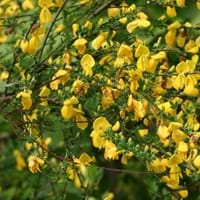Life Span
Perennial
Annual
Type
Flowering Plants, Fruits, Trees
Shrub
Origin
Central America, Europe, North America
Europe
Types
Not Available
Shrub
Habitat
Hedge, Scrubs, Woods
Cultivated Beds, Forests, meadows, Pastures, Riverbanks, Roadsides, Scrubs, wastelands, waterways
USDA Hardiness Zone
4-8
6-8
AHS Heat Zone
Not Available
8-6
Sunset Zone
Not Available
H1, 2a, 2b, 3a, 3b, 4, 5, 6, 7, 8, 9, 14, 15, 16, 17, 18, 19, 20, 21, 22
Habit
Not Available
Arching/Fountain-shaped
Flower Color
White
Yellow, Rose, Burgundy
Flower Color Modifier
Not Available
Not Available
Fruit Color
Yellow
Non Fruiting Plant
Leaf Color in Spring
Dark Green
Green
Leaf Color in Summer
Green
Green
Leaf Color in Fall
Brown, Green, Light Yellow
Green
Leaf Color in Winter
Not Available
Not Available
Leaf Shape
Oblong
Compound
Plant Season
Summer
Spring, Summer, Fall, Winter
Sunlight
Full Sun, Partial shade
Full Sun
Type of Soil
Loamy
Loam, Sand
The pH of Soil
Neutral
Acidic, Neutral
Soil Drainage
Well drained
Well drained
Bloom Time
Fall, Summer
Late Spring, Early Summer
Tolerances
Drought
Drought, Salt
Where to Plant?
Ground
Ground, Pot
How to Plant?
Grafting, Seedlings, Transplanting
Hardwood Cuttings, Seedlings
Plant Maintenance
Medium
Medium
Watering Requirements
Medium
Average Water Needs, Do Not over Water
In Summer
Lots of watering
Lots of watering
In Spring
Moderate
Moderate
In Winter
Average Water
Average Water
Soil pH
Neutral
Acidic, Neutral
Soil Type
Loamy
Loam, Sand
Soil Drainage Capacity
Well drained
Well drained
Sun Exposure
Full Sun, Partial shade
Full Sun
Pruning
Prune when plant is dormant, Remove dead or diseased plant parts
Remove damaged leaves, Remove dead branches, Remove dead leaves
Fertilizers
All-Purpose Liquid Fertilizer
All-Purpose Liquid Fertilizer
Pests and Diseases
Aphids, Curculio occidentis, Japanese Beetles, Leaf Rollers, Leafminer, Mites, Red blotch, sawflies, Scale, Stink bugs
Red blotch
Plant Tolerance
Drought
Drought
Flower Petal Number
Single
Single
Foliage Texture
Medium
Fine
Foliage Sheen
Matte
Matte
Attracts
Not Available
Butterflies
Allergy
Digestive Problems, Respiratory problems
poisonous if ingested, Skin irritation
Aesthetic Uses
Showy Purposes
Showy Purposes
Beauty Benefits
Beautiful Skin
Not Available
Environmental Uses
Food for birds
Air purification
Medicinal Uses
Anthelmintic, Antibacterial, Astringent, Hypnotic, Laxative, Refrigerant
Antirheumatic, Cardiotonic, cathartic, Diuretic, Emetic, Vasoconstrictor
Part of Plant Used
Fruits
Flowers, Leaves
Other Uses
Edible syrup, Jam, Jelly, Used As Food
Basketary, Fibre, Repellent, Tannin, Used as essential oil, Used As Food, used for making high quality paper, Used for making yellow to orange dye, Used to make baskets, brooms, hats
Used As Indoor Plant
No
No
Used As Outdoor Plant
Yes
Yes
Garden Design
Not Available
Feature Plant, Hedges, Mixed Border
Botanical Name
Malus sylvestris
CYTISUS scoparius 'Burkwoodii'
Common Name
European crab apple
Scotch Broom
In Hindi
european crab apple
cytisus scoparius
In German
Der Holzapfel, Europäischer Wildapfel
cytisus scoparius
In French
Le Boquettier, le Pommier sauvage ou Pommier des bois
cytisus scoparius
In Spanish
Malus sylvestris, el Manzano silvestre, manzano silvestre europeo
Cytisus scoparius
In Greek
Ευρωπαϊκή μήλο καβουριών
Cytisus Scoparius ή
In Portuguese
Malus sylvestris
cytisus scoparius
In Polish
Jabłoń dzika
żarnowiec
In Latin
european crab apple
scoparius cytisum
Phylum
Magnoliophyta
Magnoliophyta
Class
Magnoliopsida
Magnoliopsida
Clade
Angiosperms, Eudicots, Rosids
Angiosperms, Eudicots, Rosids
Tribe
Not Available
Not Available
Subfamily
Not Available
Not Available
Number of Species
Not Available
Not Available
Season and Care of European Crab Apple and Scotch Broom
Season and care of European Crab Apple and Scotch Broom is important to know. While considering everything about European Crab Apple and Scotch Broom Care, growing season is an essential factor. European Crab Apple season is Summer and Scotch Broom season is Summer. The type of soil for European Crab Apple is Loamy and for Scotch Broom is Loam, Sand while the PH of soil for European Crab Apple is Neutral and for Scotch Broom is Acidic, Neutral.
European Crab Apple and Scotch Broom Physical Information
European Crab Apple and Scotch Broom physical information is very important for comparison. European Crab Apple height is 25.00 cm and width 20.00 cm whereas Scotch Broom height is 150.00 cm and width 150.00 cm. The color specification of European Crab Apple and Scotch Broom are as follows:
European Crab Apple flower color: White
European Crab Apple leaf color: Dark Green
Scotch Broom flower color: Yellow, Rose and Burgundy
- Scotch Broom leaf color: Green
Care of European Crab Apple and Scotch Broom
Care of European Crab Apple and Scotch Broom include pruning, fertilizers, watering etc. European Crab Apple pruning is done Prune when plant is dormant and Remove dead or diseased plant parts and Scotch Broom pruning is done Remove damaged leaves, Remove dead branches and Remove dead leaves. In summer European Crab Apple needs Lots of watering and in winter, it needs Average Water. Whereas, in summer Scotch Broom needs Lots of watering and in winter, it needs Average Water.





